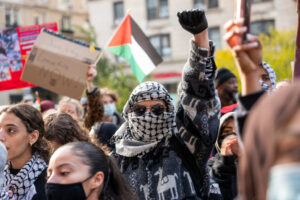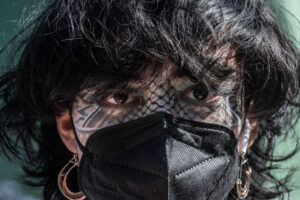The barricades. The passion. The patchouli. A campus protest and student rebellion that threatens to engulf a tired establishment. This time round, the police used flash-bang grenades rather than tear gas to clear out Hamilton Hall. But this is a detail, not a difference, and the parallels between 1968 and 2024 on the Columbia University campus are obvious. The historical rhymes extend well beyond such surface symbolism. Outraged by racism and injustice at home, protesters have coalesced around a foreign war. Like the New Left before them, Zoomers refuse to be “Good Germans”. More broadly, they oppose what to their minds is a racist, fascist, and imperialist system. Meanwhile, a bland Democratic institutionalist watches his re-election prospects wither. His wily, law-and-order foe senses opportunity.
It looks, sounds, and smells like 1968. And this is no coincidence — many of the protesters see themselves as revivalists, resurrecting the pose and the politics of a more heroic era. But a closer examination of the trajectory of the 1968 generation reveals the Columbia crop to be little more than a patchy historical shadow. Because while the 2024 generation are ultimately the grandchildren of 1968, they are also its epigones, and placing the two political movements side by side is an object lesson in the difference between the authentic and ersatz.
Mark Rudd, who led the 1968 Columbia University protests, was a typical New Leftist. He entered college from the mid-Sixties middle class — apolitical, yet vaguely jaundiced. He longed for an “intellectual avant-garde”. He had tired of watching the Civil Rights Movement unfold from the side-lines. He drifted in such frustrations until discovering Malcolm X who taught him that “the division in the world is between the oppressed—who are mainly people of color—and the oppressors—who are mainly white”. In a phrase, this is how Rudd and the New Leftists could link their domestic situation to Vietnam and American foreign policy.
This was key to turning the Civil Rights movement into a larger New Left. The batons, German shepherds, and firehoses that the racist South used as its weapons had already permanently changed how Rudd, and many in his generation, viewed their country. John Lewis, Diane Nash, and the student wing of the civil rights movement served as their activist model. Their villain was George Wallace, the segregationist Alabama governor, who was taken to define America at home. Once Vietnam was thrown into the mix, New Leftists could think of their nation as George Wallace home and abroad — racist, fascist, and irredeemably imperialist.
This 21st-century movement opts for a similar synthesis, tying their Gaza activism to their anti-racist background. Like the original New Left, the culture war over American society in the last decade has led them on a journey from racial optimism to remorseless antagonism. It began with Barack Obama, the Zoomer John Kennedy. Charismatic and cool, Obama symbolised an ascendant “post-racial” America when the nation could still believe in change through traditional political channels. But Trayvon Martin’s 2012 murder, Michael Brown’s 2014 shooting, and the Ferguson Riots began to punch holes in this fantasy before, like the Civil Rights movement in the Sixties, Donald Trump’s election and George Floyd, radicalised a generation.
Once at college, the institutional pressures were there to bake these ingredients into a very 1968 mould: the 2024 student protesters sound and act like the New Left because they are trained by an institutionalised New Left at elite universities. This is why the intone the very same language and misapply identical principles. In 1968, Rudd founded his protest upon Columbia’s “racism and support for imperialism”. Now, 56 years later, Jawuanna McAllister a Cornell University student protester defines her philosophy: “we’re antiracist, anti-imperialist, anti-colonialist… none of us can be free… unless all of us are free”. It’s Freaky Friday — the student protest edition, except this time there is no generation gap on campus.
But though they imbibe and spout the same ideas, the modern protest movement dwells in a completely different context to its grandparent. In the Sixties, elite colleges and universities were institutionally conservative: the University of California even prohibited all political activity on campus. It was that total (and unreasonable) prohibition which prompted the original free-speech movement. At Columbia meanwhile, Mark Rudd sipped sherry with “tame and bloodless” professors in dreary afternoon seminars on Aristotle. At Swarthmore, future Weather Underground leaders Cathy Wilkerson and Kathy Boudin endured curfews, dined on white tablecloths, and organised formal dinners.
Today, these very same campuses actively market themselves as Left-wing activist finishing schools. Cornell’s student union features a plaque commemorating armed takeover of the building in 1969. At Atlanta’s Emory University, Arts and Social Justice Fellows help students translate their learning into “creative activism in the name of social justice”. And Columbia, which is euphemistically called “Protest Ivy”, brings activist alumni to campus to woo potential students, while its two-semester core “Contemporary Civilization” is effectively a reading list for the 2024 activists. On the list are as many texts on the Haitian Constitution (three) as there are on the American, while the post-1945 readings are devoted exclusively to anticolonialism, race, sex and gender, and climate change. Unlike the Boomers who lived in a conservative social milieu amid establishment liberal ideas, the Zoomers scarcely encounter any contemporary notion to the Right of the Combahee River Collective or Frantz Fanon.
And this gets at the heart of the crucial difference between 2024 and 1968. Rudd, and his contemporaries, rebelled. Their movement, and its excesses, were born amid social upheaval and intellectual ferment. This certainly resulted in some misjudged actions and overheated rhetoric: when I interviewed Rudd, he freely admitted this. But one can understand, if not always defend, the New Left’s actions because of the scale of the political context. They imagined themselves battling racist oppression at home and imperialism abroad — because they were. In 1963, George Wallace had vowed to preserve segregation forever. Selma’s Bloody Sunday was a current event. Western imperialism was a present-day fact. What LBJ saw as the domino theory in Vietnam was instead a final act in Vietnam’s decades-long quest for independence, which America was denying through its war.
This iteration of the Left, by contrast, takes their canned philosophies from their elders and applies them by rote. And what they lack in originality they compensate with intellectual sloppiness. The Israel-Gaza War is not even America’s conflict. Israel is a sovereign nation governed by a prime minister, Benjamin Netanyahu, who freely ignores Joe Biden. Protesters fundamentally misunderstand the very injustices they protest. And, trained by the old-New Left, they see American racism as frozen in 1968 amber, even though the material basis for racial inequality has fundamentally shifted. In 1968, to be black was to be in the American underclass: in 1960, only 10% of African Americans held a middle-class job. But the very victories of Civil Rights have changed that equation.
William Julius Wilson, the preeminent urban sociologist of his era, finds that class has become stickier than race in determining life chances. For the half of all black families that are now middle-class as a result, this is good news. And though they still suffer the worst, working-class African Americans are the victims of the same globalised economy as their white and brown brethren. There has not been a complete revolution: drive along any of America’s 955 Martin Luther King Boulevards and you will see reasons for pessimism. African-American men are still disproportionately victims of police violence. But this no longer a product of racialised legislation, but of the fact that poor Americans, of all races, are the disproportionate victims of a militarised police state.
And in several ways this is worse than 1968. Because this time it is the underclass, the Palestinians, who pay the price for elite hyperbole. Benjamin Netanyahu can more easily ignore shrill exaggerations: the war grinds on; Palestinians suffer. The Zoomer Left hasn’t responded to this reality — it doesn’t even try. Instead, it sets about exemplifying Rob Henderson’s luxury belief motif, where anti-war activism confers social prestige on the educated elite. The cultural geography of the current protests is equally telling in this regard. These protests are stationed at elite campuses, the “Ivy plus” institutions where children of elites predominate. The New Left admittedly started with upper-middle-class kids at elite schools. But hundreds of middle-class state colleges eventually erupted in protest. In 1970, normie Kent State University in Ohio became the symbol of a mass youth rebellion.
Anti-racism at home and Zionism-as-imperialism abroad is a nifty way to redirect focus from this reality. And just as Tom Barson, a veteran of the 1968 Columbia uprising, has written, the roots of the tumult are not so much social anomie as it is “deflection”. Otherwise, the student elites might observe their professional middle class has gobbled up 83% of the America’s wealth since 1989. Or that the income gap between college and non-college was a mere 10% in the Seventies (today it is 70%). They could notice that the just over 500, mostly urban, coastal counties where they reside is home to 70% of all wealth, and that an epidemic of “deaths of despair” tears through the thousands of counties left behind. They might even notice that today it is college that separates the underclass from everyone else — and that it should be the cause of social protest, not its incubator.
The Columbia protesters are too coiled up in political introversion to notice these historical ironies. And that is why they will only end up repeating the greatest Sixties irony of them all. After all the fury of that decade, its greatest political achievement was to pave Richard Nixon’s route to the presidency, shattering the coalition that had carried LBJ to a landslide in 1964. By broadcasting the worst of the modern Left to America and its “silent majority”, these students can do the same, sabotaging the current government and boosting a crook to the White House.
Disclaimer
Some of the posts we share are controversial and we do not necessarily agree with them in the whole extend. Sometimes we agree with the content or part of it but we do not agree with the narration or language. Nevertheless we find them somehow interesting, valuable and/or informative or we share them, because we strongly believe in freedom of speech, free press and journalism. We strongly encourage you to have a critical approach to all the content, do your own research and analysis to build your own opinion.
We would be glad to have your feedback.
Source: UnHerd Read the original article here: https://unherd.com/



